DL-Norephedrine hydrochloride
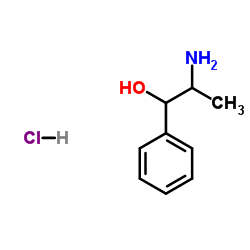
DL-Norephedrine hydrochloride structure
|
Common Name | DL-Norephedrine hydrochloride | ||
|---|---|---|---|---|
| CAS Number | 154-41-6 | Molecular Weight | 187.667 | |
| Density | 1.071 g/cm3 | Boiling Point | 288.1ºC at 760 mmHg | |
| Molecular Formula | C9H14ClNO | Melting Point | 194-196 °C(lit.) | |
| MSDS | Chinese USA | Flash Point | 128.1ºC | |
| Symbol |

GHS07 |
Signal Word | Warning | |
| Name | DL-Norephedrine hydrochloride |
|---|---|
| Synonym | More Synonyms |
| Density | 1.071 g/cm3 |
|---|---|
| Boiling Point | 288.1ºC at 760 mmHg |
| Melting Point | 194-196 °C(lit.) |
| Molecular Formula | C9H14ClNO |
| Molecular Weight | 187.667 |
| Flash Point | 128.1ºC |
| Exact Mass | 187.076385 |
| PSA | 46.25000 |
| LogP | 2.56950 |
| Vapour Pressure | 0.0011mmHg at 25°C |
| Index of Refraction | 1.557 |
| Storage condition | ?20°C |
Synonym:alpha-(1-Aminoethyl)benzyl alcohol hydrochloride; DL-Phenylpropanolamine hydrochloride ; Alpha-hydroxy-beta-Aminopropylbenzene Hydrochloride; Propadrine Hydrochloride Section 2 - COMPOSITION, INFORMATION ON INGREDIENTS
Risk Phrases: 22 Section 3 - HAZARDS IDENTIFICATION EMERGENCY OVERVIEW
Harmful if swallowed.Light sensitive. Potential Health Effects Eye: May cause eye irritation. Skin: May cause skin irritation. Ingestion: May cause irritation of the digestive tract. May be harmful if swallowed. Inhalation: May cause respiratory tract irritation. Chronic: No information found. Section 4 - FIRST AID MEASURES Eyes: Flush eyes with plenty of water for at least 15 minutes, occasionally lifting the upper and lower eyelids. Get medical aid immediately. Skin: Get medical aid. Flush skin with plenty of water for at least 15 minutes while removing contaminated clothing and shoes. Wash clothing before reuse. Ingestion: If victim is conscious and alert, give 2-4 cupfuls of milk or water. Never give anything by mouth to an unconscious person. Get medical aid immediately. Inhalation: Remove from exposure and move to fresh air immediately. If not breathing, give artificial respiration. If breathing is difficult, give oxygen. Get medical aid. Notes to Physician: Treat symptomatically and supportively. Antidote: None reported. Section 5 - FIRE FIGHTING MEASURES General Information: As in any fire, wear a self-contained breathing apparatus in pressure-demand, MSHA/NIOSH (approved or equivalent), and full protective gear. During a fire, irritating and highly toxic gases may be generated by thermal decomposition or combustion. Extinguishing Media: In case of fire, use water, dry chemical, chemical foam, or alcohol-resistant foam. Section 6 - ACCIDENTAL RELEASE MEASURES General Information: Use proper personal protective equipment as indicated in Section 8. Spills/Leaks: Clean up spills immediately, observing precautions in the Protective Equipment section. Sweep up or absorb material, then place into a suitable clean, dry, closed container for disposal. Avoid generating dusty conditions. Provide ventilation. Section 7 - HANDLING and STORAGE Handling: Wash thoroughly after handling. Remove contaminated clothing and wash before reuse. Minimize dust generation and accumulation. Avoid contact with eyes, skin, and clothing. Avoid ingestion and inhalation. Use with adequate ventilation. Storage: Store in a cool, dry, well-ventilated area away from incompatible substances. Keep containers tightly closed. Section 8 - EXPOSURE CONTROLS, PERSONAL PROTECTION Engineering Controls: Use adequate ventilation to keep airborne concentrations low. Exposure Limits CAS# 154-41-6: Personal Protective Equipment Eyes: Wear appropriate protective eyeglasses or chemical safety goggles as described by OSHA's eye and face protection regulations in 29 CFR 1910.133 or European Standard EN166. Skin: Wear appropriate protective gloves to prevent skin exposure. Clothing: Wear appropriate protective clothing to prevent skin exposure. Respirators: Follow the OSHA respirator regulations found in 29 CFR 1910.134 or European Standard EN 149. Use a NIOSH/MSHA or European Standard EN 149 approved respirator if exposure limits are exceeded or if irritation or other symptoms are experienced. Section 9 - PHYSICAL AND CHEMICAL PROPERTIES Physical State: Powder Color: white Odor: crude benzoic acid pH: Not available. Vapor Pressure: Not available. Viscosity: Not available. Boiling Point: Not available. Freezing/Melting Point: 194.00 - 196.00 deg C Autoignition Temperature: Not applicable. Flash Point: Not applicable. Explosion Limits, lower: Not available. Explosion Limits, upper: Not available. Decomposition Temperature: Solubility in water: Soluble. Specific Gravity/Density: Molecular Formula: C9H13NO.HCl Molecular Weight: 187.67 Section 10 - STABILITY AND REACTIVITY Chemical Stability: Stable under normal temperatures and pressures. Conditions to Avoid: Incompatible materials, light, dust generation, strong oxidants. Incompatibilities with Other Materials: Strong oxidizing agents. Hazardous Decomposition Products: Hydrogen chloride, nitrogen oxides, carbon monoxide, irritating and toxic fumes and gases, carbon dioxide, nitrogen. Hazardous Polymerization: Has not been reported. Section 11 - TOXICOLOGICAL INFORMATION RTECS#: CAS# 154-41-6: DN4200000 LD50/LC50: CAS# 154-41-6: Oral, mouse: LD50 = 150 mg/kg; Oral, rat: LD50 = 1490 mg/kg. Carcinogenicity: DL-Norephedrine hydrochloride - Not listed by ACGIH, IARC, or NTP. Other: See actual entry in RTECS for complete information. Section 12 - ECOLOGICAL INFORMATION Other No information available. Section 13 - DISPOSAL CONSIDERATIONS Dispose of in a manner consistent with federal, state, and local regulations. Section 14 - TRANSPORT INFORMATION IATA Not regulated as a hazardous material. IMO Not regulated as a hazardous material. RID/ADR Not regulated as a hazardous material. Section 15 - REGULATORY INFORMATION European/International Regulations European Labeling in Accordance with EC Directives Hazard Symbols: XN Risk Phrases: R 22 Harmful if swallowed. Safety Phrases: WGK (Water Danger/Protection) CAS# 154-41-6: No information available. Canada CAS# 154-41-6 is listed on Canada's DSL List. CAS# 154-41-6 is not listed on Canada's Ingredient Disclosure List. US FEDERAL TSCA CAS# 154-41-6 is listed on the TSCA inventory. SECTION 16 - ADDITIONAL INFORMATION N/A |
CHEMICAL IDENTIFICATION
HEALTH HAZARD DATAACUTE TOXICITY DATA
|
| Symbol |

GHS07 |
|---|---|
| Signal Word | Warning |
| Hazard Statements | H302 |
| Precautionary Statements | P301 + P312 + P330 |
| Personal Protective Equipment | dust mask type N95 (US);Eyeshields;Gloves |
| Hazard Codes | Xn: Harmful; |
| Risk Phrases | R22 |
| Safety Phrases | S22-S36/37/39-S45 |
| RIDADR | UN 2811 |
| WGK Germany | 3 |
| RTECS | DN4200000 |
| HS Code | 2922199090 |
|
~82% 
DL-Norephedrine... CAS#:154-41-6 |
| Literature: Oppong-Boachie, Francis Kwabena Bulletin des Societes Chimiques Belges, 1985 , vol. 94, # 4 p. 293 - 298 |
|
~% 
DL-Norephedrine... CAS#:154-41-6 |
| Literature: Yakugaku Zasshi, , vol. 48, p. 124 Chem. Zentralbl., , vol. 100, # I p. 240 Yakugaku Zasshi, , # 540 p. 18 Chem. Zentralbl., , vol. 98, # I p. 2539 Justus Liebigs Annalen der Chemie, , vol. 470, p. 174 Chem. Zentralbl., , vol. 99, # II p. 2553 |
|
~% 
DL-Norephedrine... CAS#:154-41-6 |
| Literature: Yakugaku Zasshi, , # 540 p. 18 Chem. Zentralbl., , vol. 98, # I p. 2539 Justus Liebigs Annalen der Chemie, , vol. 470, p. 174 Chem. Zentralbl., , vol. 99, # II p. 2553 |
| HS Code | 2922199090 |
|---|---|
| Summary | 2922199090. other amino-alcohols, other than those containing more than one kind of oxygen function, their ethers and esters; salts thereof. VAT:17.0%. Tax rebate rate:13.0%. . MFN tariff:6.5%. General tariff:30.0% |
|
Forensic analysis of hallucinogenic mushrooms and khat (Catha edulis Forsk) using cation-exchange liquid chromatography.
Forensic Sci. Int. 195(1-3) , 160-4, (2010) Hallucinogenic mushrooms (e.g. Psilocybe and Panaeolus species) as well as leaves and young shoots of the khat tree (Catha edulis Forsk) are illicit drugs in many countries. The exact concentration of... |
|
|
Keep an eye on the pupil: developing countries under chemical attack.
Intern. Emerg. Med. 4(3) , 231-3, (2009)
|
|
|
Experiences with carrier-mediated transport in liquid-phase microextraction.
J. Chromatogr. Sci. 44(6) , 308-16, (2006) Different organic borates, phosphates, sulphates, and carboxylic acids are evaluated as extraction carriers in three-phase liquid-phase microextraction (LPME). Hydrophilic basic drugs form ion-pairs w... |
| NOREPHEDRINE HCL |
| α-(1-Aminoethyl)benzyl alcohol hydrochloride |
| a-Hydroxy-b-aminopropylbenzene Hydrochloride |
| dl-NOREPHEDRINE HCl |
| mucorama |
| α-Hydroxy-β-aminopropylbenzene hydrochloride |
| propadrinehydrochloride |
| obestat |
| Benzenemethanol, α-(1-aminoethyl)-, hydrochloride (1:1) |
| a-(1-Aminoethyl)benzyl Alcohol Hydrochloride |
| monydrin |
| DL-1-Phenyl-2-amino-1-propanol monohydrochloride |
| 2-Amino-1-phenyl-1-propanol hydrochloride (1:1) |
| PHENYLPROPANOLAMINE HCL |
| 1-Phenyl-2-amino-1-propanol Hydrochloride |
| LincomycinHydrocloride |
| Phenylpropanolamine hydrochloride |
| 2-Amino-1-phenyl-1-propanol Hydrochloride |
| Benzyl alcohol, α-(1-aminoethyl)-, hydrochloride, (±)- |
| 2-amino-1-phenylpropan-1-ol hydrochloride |
| EINECS 205-826-7 |
| MFCD00013019 |
| benzenemethanol, α-(1-aminoethyl)-, hydrochloride |
| Phenyl propanolamine hydrochloride |
| 2-amino-1-phenyl-1-propanol monohydrochloride |
| 2-Amino-1-phenylpropan-1-ol hydrochloride (1:1) |
| (±)-2-Amino-1-phenyl-1-propanol hydrochloride |


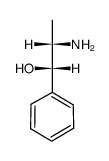

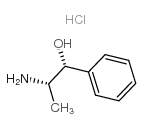 CAS#:3198-15-0
CAS#:3198-15-0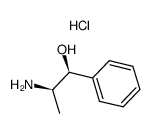 CAS#:40626-29-7
CAS#:40626-29-7 CAS#:492-41-1
CAS#:492-41-1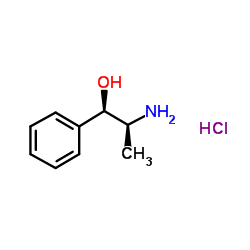 CAS#:37577-28-9
CAS#:37577-28-9 CAS#:492-39-7
CAS#:492-39-7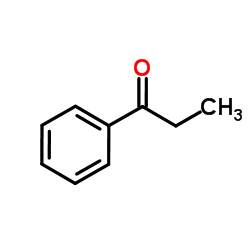 CAS#:93-55-0
CAS#:93-55-0